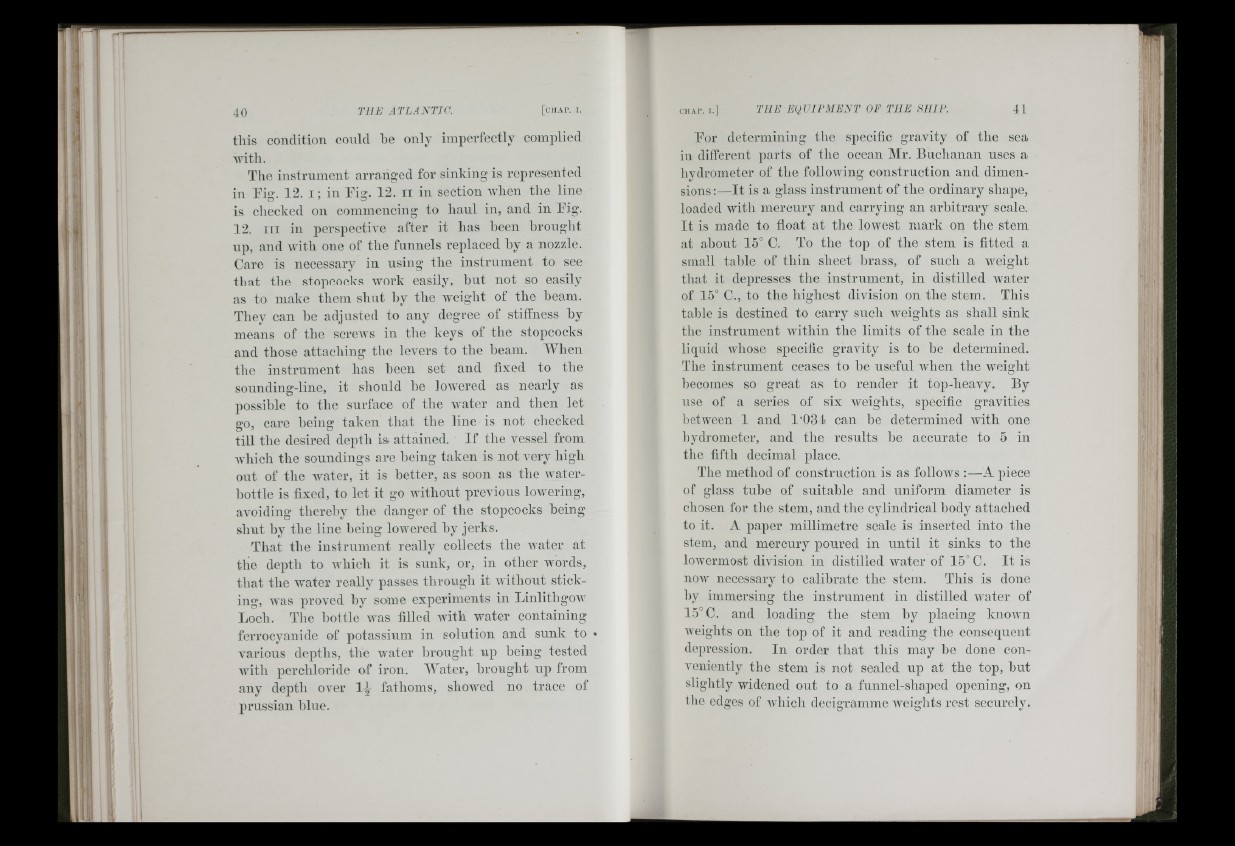
this condition could he only imperfectly complied
Avith.
The instrument arranged for sinking is represented
in Tig. 12. i; in Tig. 12. ii in section AA’lien the line
is checked on commencing to haul in, and in Tig.
12. HI in perspectiA’e after it has heen hrouglit
np, and AA’ith one of the funnels replaced hy a nozzle.
Care is necessary in using the instrument to see
that the stopcocks Avork easily, but not so easily
as to make them shut hy the Aveight of the heam.
They can he adjusted to any degree of stiffness by
means of the screAA’s in the keys ol the stopcocks
and those attaching the levers to the beam. When
the instrument has heen set and fixed to the
soiinding-line, it should he loAvered as nearly as
possible to the surface of the Avater and then let
go, care heing taken that the line is not checked
till the desired depth i& attained. I f the vessel from
Avhich the soundings are being taken is not very high
out of the Avater, it is better, as soon as the Avater-
hottle is fixed, to let it go Avithout previous lowering,
avoiding thereby the danger of the stopcocks heing
shut by the line heing loAA’ered hy jerks.
That the instrument really collects the Avater at
tlie depth to Avhich it is sunk, or, in other Avords,
tliat the Avater really passes through it Avithout sticking,
Avas proved hy some experiments in LinlithgOAV
Loch. The hottle Avas filled with water containing
ferrocyanide of potassium in solution and sunk to ♦
A’arious depths, the Avater hronght up heing tested
Avith perchloride of iron. Water, brought up from
any depth over 1^ fathoms, show’ed no trace of
Prussian blue.
Tor determining the specific gravity of the sea
in different parts of the ocean Mr. Buchanan uses a
hydrometer of the folloAving construction and dimensions;—
It is a glass instrument of the ordinary shape,
loaded witli mercury and carrying an arbitrary scale.
It is made to float at tlie lowest mark on the stem
at ahout 15° C. To the top of the stem is fitted a
small tahle of thin sheet brass, of such a weight
that it depresses the instrument, in distilled Avater
of 15° C., to the highest division on the stem. This
tahle is destined to carry such Aveights as shall sink
the instrument Avithin the limits of the scale in the
liquid whose specific gravity is to be determined.
The instrument ceases to he useful Avhen the w’cight
becomes so great as to render it top-heavy. By
use of a series of six Aveights, specific gravities
hetween 1 and 1 ‘031 can be determined Avith one
hydrometer, and the results he accurate to 5 in
the fifth decimal place.
The method of construction is as folloAvs :—A piece
of glass tuhe of suitahle and uniform diameter is
chosen for the stem, and the cylindrical body attached
to it. A paper millimetre scale is inserted into the
stem, and mercury poured in until it sinks to the
loAvermost division in distilled water of 15° C. It is
noAv necessary to calibrate the stem. This is done
hy immersing the instrument in distilled Avater of
15° C. and loading the stem by placing knoAvn
Aveights on the top of it and reading the consequent
depression. In order that tliis may he done conveniently
the stem is not sealed np at the top, hut
slightly widened out to a funnel-shaped opening, on
the edges of Avhich decigramme Aveights rest securely.
ill
I
Hr